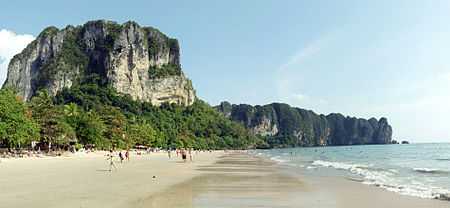Krabi
| Krabi กระบี่ | |
|---|---|
| Town | |
 | |
| Country |
|
| Province | Krabi Province |
| Population (2010) | |
| • Total | 52,867[1] |
| Time zone | ICT (UTC+7) |

Krabi (Thai: กระบี่) is a town (thesaban mueang) on the west coast of southern Thailand at the mouth of the Krabi River where it empties in Phang Nga Bay. As of 2010 the town had a population of 52,867. The town is the capital of Krabi Province and Krabi District. Tourism is an important industry.
Administration
The town covers the tambon Paknam and Krabi Yai of Krabi district, and is subdivided into 10 communities (chumchon).
Location
Krabi is a southern province on Thailand's Andaman seaboard with perhaps the country's oldest history of continued settlement. After dating stone tools, ancient colored pictures, beads, pottery, and skeletal remains found in the province's many cliffs and caves, it is thought that Krabi has been home to Homo sapiens since c. 25,000–35,000 BCE. In recorded times it was called the "Ban Thai Samor", and was one of twelve towns that used, before people were widely literate, the monkey for their standard. At that time, c. 1200 CE, Krabi was tributary to the Kingdom of Ligor, a city on the Kra Peninsula's east coast better known today as Nakhon Si Thammarat.
Climate
Facing the Andaman Sea, like Phuket, Krabi is subject to a 6-month rainy season between May and November, often with sustained heavy rains for days at a time during the monsoons.[2]
History
At the start of the Rattanakosin or Bangkok period in the late eighteenth century, when the capital was finally settled at Bangkok, an elephant kraal was established in Krabi by order of Chao Phraya Nakorn (Noi), the governor of Nakhon Si Thammarat, which was by then a part of the Thai Kingdom. He sent his vizier, the Phra Palad, to oversee this task, which was to ensure a regular supply of elephants for the larger town. So many followers emigrated in the steps of the Phra Palad that soon Krabi had a large community in three different boroughs: Pakasai, Khlong Pon, and Pak Lao. In 1872, King Chulalongkorn graciously elevated these to town status, called Krabi, a word that preserves in its meaning the monkey symbolism of the old standard. The town's first governor was Luang Thep Sena, though it continued a while as a dependency of Nakhon Si Thammarat. This was changed in 1875, when Krabi was raised to a fourth-level town in the old system of Thai government. Administrators then reported directly to the central government in Bangkok, and Krabi's history as an entity separate from other provinces, had begun.
Tourism

Much of the province has been given over to several national parks. Top destinations are Hat Noppharat Thara, Ao Nang,[3] Railay, and Ko Phi Phi National Park. The province includes over 80 smaller islands such as (Ko Lanta) and Phi Phi, well-known to adventurers, yachtsmen, scuba-divers, snorkelers, and day-trippers from Phuket.
Ko Lanta National Park, also in Krabi Province, includes several coral-fringed islands with well-known diving sites. The largest island, Ko Lanta Yai, is the site of park headquarters, and is also home to Chao Le, or sea gypsies who sustain themselves largely through fishing. The islands are best visited during the drier months of October through April.
Kayaking, sailing, bird watching, snorkeling are also among top activities. In the interior, two predominantly mainland national parks, Khao Phanom Bencha and Than Bokk-horani, offer inland scenic attractions including waterfalls and caves, and opportunities for trekking, bird watching and eco-tours.
The rock faces at Railay Beach near Ao Nang have attracted climbers from all over the world and each year are the venue for the Rock and Fire Festival. There are several rock climbing schools at Railay Beach.
Transport
Since 1999 the town has been served by the international Krabi Airport. Passing through the town is Phetkasem Road (Thailand Route 4).

References
External links
| Wikimedia Commons has media related to Krabi Town. |
Coordinates: 8°3′33″N 98°55′8″E / 8.05917°N 98.91889°E